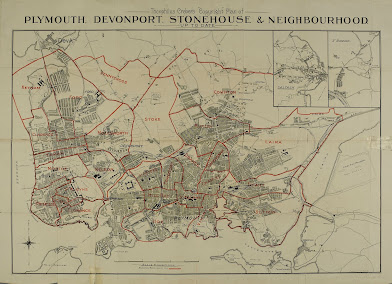Theophilus Creber
In 2016 the British Library held an exhibition “There will be fun” centred on the entertainment industry of the Victorian era. Laurence Worms in his blog The Bookhunter on Safari mentions Theophilus Creber in connection with a number of posters and a newspaer clöipping. The following is his portrayal of Creber in connection with the exhibits: This Sanger poster [illustrated below] is by the prosperous Theophilus Creber (1845-1902) of Plymouth, who described himself as a “show printer”. Brought up in Devonport Workhouse (not as an inmate, his father was the teacher), he was a man in love with his work to the extent that he took his own lease on the old Olympia Theatre in Plymouth and re-opened it in 1887 as a Theatre of Varieties, promising “first class entertainments … free from anything objectionable in the slightest degree”. By 1898 he had taken over the Theatre Royal at Eastbourne, spending a fortune on refurbishing it.[1]
He goes on to explain the contents of a newspaper clipping which was illustrated: An account in “The Era” describes the work carried out in elaborate detail. He also owned Fred Ginster’s Circus, which was put up for auction, lock, stock and barrel, later that year – possibly to pay for the refurbishment: “The Circus Plant is in First-rate Condition, and is now Travelling, and will be up to Day of Sale. It comprises the following :– 100 Horses and Ponies, Procession Carriages, Living Waggons, Luggage Waggons, Pony Traps, Splendid Sets of Red and Blue Leather Harness, Waggon Harness, &c.; very Large Two-Pole Tent, with Wallings and Seating Complete; Horse Tents, Dressing Tents, Property Tents, Procession Dresses, Shields, Banners, Flags, &c.; Twenty-five of the Best and Cleverest Horses in the Circus Business; Four Black Hungarian Horses, Performing Together, and to do Separate Trick and Menage Acts; Dignity and Impudence, the Big Horse and the Little Pony, which do Three Acts; Ten of the Best Ring Horses in the Business, go to every Act; the Smallest and Prettiest Ponies, Two White Sacred Mules, 17h. high, &c” (The Era, 17th September 1898). His business survived until 1932 when it merged with the Salisbury Press.
The Eyre brothers issued their Post Office Plymouth District Directory in 1881 but by 1900 it had already been through two different publishers before Theophilus Creber took it over in 1900. He managed to publish five ditioons before it was again taken over, this time by Swiss of Plymouth. The 13th edition has a map specially pareped by Creber.[2]
Size 493 x 691 mm. SIX INCHES TO THE MILE (6 miles = ### mm).
THEOPHILUS CREBER´S “COPYRIGHT” PLAN OF PLYMOUTH, DEVONPORT, STONEHOUSE, AND NEIGHBOURHOOD UP-TO-DATE across the top of the map above the border in 3 lines. Signature: CREBER LITHO PLYMOUTH (Ee). There is note on boundaries to wards which are coloured red. Scale at bottom (Ce). There is a small compass point (Ae).
The map area extends only as far as the city limits from Hamoaze to The Laira. There are two insets top right of Saltash and St Budeaux.
1. 1901 Eyre´s Post Office Plymouth and Devonport District Directory 13th
Edition.
Plymouth. T Creber. 1901. Bod, PLY[3], DevA[4] (illustrated).
RETURN to Main Catalogue
NOTES:
[1] See https://ashrarebooks.com/2016/10/20/there-will-be-fun/.
The Sanger poster is illustrated but is also illustrated online at https://imagesonline.bl.uk/asset/48354.
Courtesyof the British Library.
[2] For full details of the directory under Eyre´s name see https://eyre-brothers-directories-guides.blogspot.com/.
[3] PLY has a copy of the directory with no map and WDRO a copy of this map stored at 2766. They probably belong together.
[4] DevA catalogue lists a copy of this map under PM B/PLY/1904/CRE. It has directories for 1900-1904, all by Creber, but none contains a map.






No comments:
Post a Comment